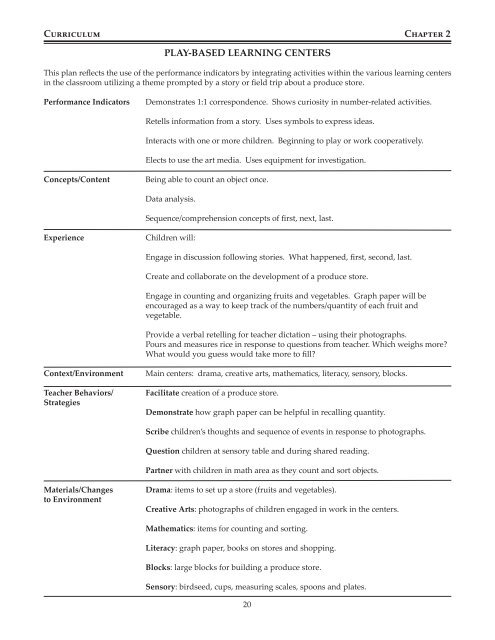Early Childhood - Connecticut State Department of Education
Early Childhood - Connecticut State Department of Education
Early Childhood - Connecticut State Department of Education
You also want an ePaper? Increase the reach of your titles
YUMPU automatically turns print PDFs into web optimized ePapers that Google loves.
Curriculum Chapter 2<br />
PLAY-BASED LEARNING CENTERS<br />
This plan reflects the use <strong>of</strong> the performance indicators by integrating activities within the various learning centers<br />
in the classroom utilizing a theme prompted by a story or field trip about a produce store.<br />
Performance Indicators Demonstrates 1:1 correspondence. Shows curiosity in number-related activities.<br />
Retells information from a story. Uses symbols to express ideas.<br />
Interacts with one or more children. Beginning to play or work cooperatively.<br />
Elects to use the art media. Uses equipment for investigation.<br />
Concepts/Content Being able to count an object once.<br />
Data analysis.<br />
Experience Children will:<br />
Sequence/comprehension concepts <strong>of</strong> first, next, last.<br />
Engage in discussion following stories. What happened, first, second, last.<br />
Create and collaborate on the development <strong>of</strong> a produce store.<br />
Engage in counting and organizing fruits and vegetables. Graph paper will be<br />
encouraged as a way to keep track <strong>of</strong> the numbers/quantity <strong>of</strong> each fruit and<br />
vegetable.<br />
Provide a verbal retelling for teacher dictation – using their photographs.<br />
Pours and measures rice in response to questions from teacher. Which weighs more?<br />
What would you guess would take more to fill?<br />
Context/Environment Main centers: drama, creative arts, mathematics, literacy, sensory, blocks.<br />
Teacher Behaviors/ Facilitate creation <strong>of</strong> a produce store.<br />
Strategies<br />
Demonstrate how graph paper can be helpful in recalling quantity.<br />
Scribe children’s thoughts and sequence <strong>of</strong> events in response to photographs.<br />
Question children at sensory table and during shared reading.<br />
Partner with children in math area as they count and sort objects.<br />
Materials/Changes Drama: items to set up a store (fruits and vegetables).<br />
to Environment<br />
Creative Arts: photographs <strong>of</strong> children engaged in work in the centers.<br />
Mathematics: items for counting and sorting.<br />
Literacy: graph paper, books on stores and shopping.<br />
Blocks: large blocks for building a produce store.<br />
Sensory: birdseed, cups, measuring scales, spoons and plates.<br />
20

















